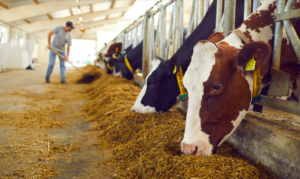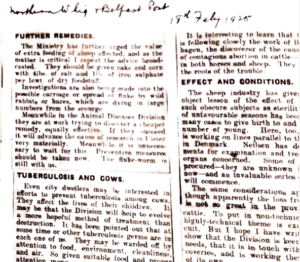This week, I introduce my short research project on bacterial infections, with specific focus on tuberculosis (TB) as a zoonotic disease; these are diseases that can move from one animal species (including humans) to another. After spending two and a half months immersed in archival materials, I realised that this focus provided a good means to explore different ideas of animal welfare and how welfare was implicated in public health issues between 1915 and 1945.

The OneKind archives in store at the CRC
The Royal (Dick) Veterinary College, Royal Zoological Society of Scotland and OneKind animal charity (formerly the Scottish Society for the Prevention of Vivisection or SSPV), all approached infectious disease management in ways that defined welfare and cruelty differently. While I revealed these differences in my research, I also considered whether espoused ideas could be seen as precursors to contemporary conceptions of One Health or One Welfare. Here I’ll share a quick introduction to One Health and One Welfare and a bit of background about TB in the UK. Later this week, I’ll share my findings on this topic based on archival research.
What do we mean by One Health and One Welfare?
The concept of One Health (OH) was first referred to in 2003 as response or means to address the public health threat of zoonotic diseases. OH has been championed primarily by veterinarians (Cassidy 2018). The international One Health High Level Expert Panel developed a globally recognised definition:
‘One Health is an integrated, unifying approach that aims to sustainably balance and optimize the health of people, animals and ecosystems. It recognizes the health of humans, domestic and wild animals, plants, and the wider environment (including ecosystems) are closely linked and inter-dependent.’ (Mettenleiter et al 2023)
But One Health has been criticised for being too anthropocentric and not adequately attending to animal welfare and wellbeing (Lindenmayer and Kaufman 2021). One Welfare is meant as a corrective and focuses on interconnections between animal welfare and wellbeing, human wellbeing and the environment, thus extending the One Health focus only on health (Pinillos 2018). The One Welfare Framework, developed by Pinillos (2018), includes themes that give equal or at least greater consideration to animals alongside humans in environments. These themes include:
- interconnections between animal abuse, human abuse and neglect;
- socio-economic aspects linked to animal welfare;
- connection between farm animal welfare, farmer well-being and food security;
- conservation, sustainability and connections between biodiversity, environment and animal-human wellbeing.
One Welfare also focuses on prevention, to understand ‘root causes and drivers’ of risks to health and wellbeing. I considered these concepts when investigating organisational approaches to animal welfare and human health in the archival materials. Now a brief introduction to the history of TB in the UK.

Dairy cows (photo: shutterstock)
Background: TB in the UK
TB is an ancient disease in the context of Europe and the UK. There are three types of TB that feature in the archival collections: Mycobacterium tuberculosis (TB) which causes disease in humans and can infect other mammals and parrots (Schneider et al 2008), M. bovis or bTB which causes TB in cows and infects humans and other animals through meat and milk product consumption (McFarlane 1990), and M. avium which primarily afflicts birds but can occasionally infect humans and other animal species (Blessington et al 2021).
Many individuals are resistant to serious infection by M. tuberculosis, but certain factors cause vulnerability including living conditions, diet (malnutrition), age and suffering from other illnesses (McFarlane 1990). This type of TB became most virulent in the nineteenth century in the UK and Europe in overcrowded conditions with poverty but declined in the twentieth century; increases occurred during the world wars due to increased conditions of impoverishment (Glaziou et al 2018). Edinburgh championed a campaign to fight TB that became the root of the national campaign in the late nineteenth century (McFarlane 1990). In 1882, Robert Koch identified and isolated the tubercle bacillus, grew it in animal serum and introduced it into laboratory animals who then developed TB (Barberis et al 2017). A vaccine, Bacille Calmette-Guerin (BCG), discovered by scientists at the Pasteur Institute, derived from a bovine TB strain, was trialled successfully on animals in 1919, following Koch’s work, with use of the vaccine on infants by 1924 (Luca and Mihaescu 2013). BCG successfully prevents disease in children, but immunity diminishes with time so that adults have weakened protection (Fatima et al 2020). Despite a vaccine and attempts to improve upon it, TB has not been eradicated, still considered a public health issue in Scotland (Public Health Scotland 2023).

Northern Whig & Belfast Post, 1925, Royal (Dick) Veterinary College, Newspaper Clippings 1923-1929 (EUA IN2/6/1)
Cases of bovine TB were lower than human TB historically in human populations in the UK, but concerning from a public health perspective due to child deaths (Waddington 2004). Infected cow’s milk and meat caused infection in humans. Milk, if properly pasteurised, was safe to drink, but most milk was unpasteurised up to 1939, with an anti-pasteurisation campaign influential between 1900 to 1930 (Atkins 2000); divisions formed even within the medical profession, with some doctors for and some against pasteurisation. The UK Government ‘Milk in Schools’ programme, to address malnourishment in British children, a public health issue, led to a greater number of children at risk of contracting bTB from infected milk during this time period (Atkins 2000). Other measures to reduce public health risk from bovine TB, aside from pasteurisation, developed from 1920 included a skin test for cattle and in the 1950s, compulsory testing of cows and culling of those positive for TB (Waddington 2004).
Finally, while transmission to humans has been considered low risk, M. avium infects those with compromised immune systems, and has been considered a public health concern. A vaccine has not been developed for avian TB, and treatment with antibiotics could lead to antimicrobial resistance, so responses to infections in farmed birds such as chickens, for instance, involved killing infected birds and preventative measures (Kwaghe et al 2015).
Look out for the next blog post where I’ll share some of my findings!
References
Peter Atkins, ‘The pasteurisation of England: the science, culture and health implications of milk processing, 1900-1950’, in David Smith and Jim Phillips (Eds.), Food Science, Policy and Regulation in the Twentieth Century: international and comparative perspectives, Abingdon: Routledge, 2000, pp. 37-52, 40.
I. Barberis, N.L. Bragazzi, L. Galluzzo and M. Martini, ‘The history of tuberculosis: from the first historical records to the isolation of Koch’s bacillus’, Journal of Preventive Medicine and Hygiene (2017) 58(1), pp. E9-E12, E11.
Jacque Blessington, Judie Steenberg, Terry M. Phillips, Margaret Highland, Corinne Kozlowski and Ellen Dierenfeld, ‘Biology and Health of Tree Kangaroos in Zoos’, in Lisa Dabek, Peter Valentine, Jacque Blessington and Karin R. Schwartz (eds.), Biodiversity of World: Conservation from Genes to Landscapes, Academic Press, 2021, pp. 285-307.
Angela Cassidy, ‘Humans, other animals and “one health” in the early twenty-first century’, in Abigail Woods, Rachel Dentinger, Angela Cassidy and Michael Bresalier (eds.), Animals and the Shaping of Modern Medicine: One Health and its Histories. London: Palgrave Macmillan, 2018, pp. 193-236,193.
Samreen Fatima, Anjna Kumari, Gobardhan Das and Ved Prakash Dwivedi, ‘Tuberculosis vaccine: A journey from BCG to present’, Life Sciences (2020) 252, p. 117594.
Philippe Glaziou, Katherine Floyd and Mario Raviglione, ‘Trends in tuberculosis in the UK’, Thorax (2018) 73, pp. 702-703, 702.
A.V. Kwaghe, M.D. Ndahi, J.G. Usman, C.T. Vakuru, V.N. Iwar, J.A. Ameh and A.G. Ambali, ‘A review on avian tuberculosis (Avian mycobacteriosis)’, CABI Reviews (2015), pp. 1–17, 2.
Joann Lindenmayer and Gretchen Kaufman, ‘One health and one welfare’, in Tanya Stevens (ed.), One Welfare in Practice: the role of the veterinarian. Abingdon: CRC Press, 2021, pp. 1-30, 1.
Simona Luca and Traian Mihaescu, ’History of BCG Vaccine’, Maedica (Bucur) (2013) 8(1), pp. 53-58, 54.
Neil McFarlane, Tuberculosis in Scotland, 1870-1960, PhD thesis, University of Glasgow, 1990, p. 11.
T.C. Mettenleiter, W. Markotter, D.F. Charron et al, ‘The One Health high-level expert panel (OHHLEP)’. One Health Outlook (2023) 5 (18), pp. 1-8, 3.
Rebeca García Pinillos, ‘One welfare, companion animals and their vets’, Companion Animal (2018) 23 (10), p. 598.
Public Health Scotland, ‘2021 Tuberculosis Annual Report Published for Scotland’ (21, February, 2023), 2021 Tuberculosis Annual Report for Scotland published – News – Public Health Scotland, accessed [22 February 2024].
Susanne Schneider, Julian Schlömer, Maria-Elisabeth Krautwald-Junghanns and Elvira Richter, ‘Transmission of tuberculosis between men and pet birds: a case report’, Avian Pathology (2008) 37(6), pp. 589-592.
Keir Waddington, ‘To Stamp Out “So Terrible a Malady”: Bovine Tuberculosis and Tuberculin Testing in Britain, 1890–1939’, Medical History (2004) 48(1), pp. 29-48, 29.
